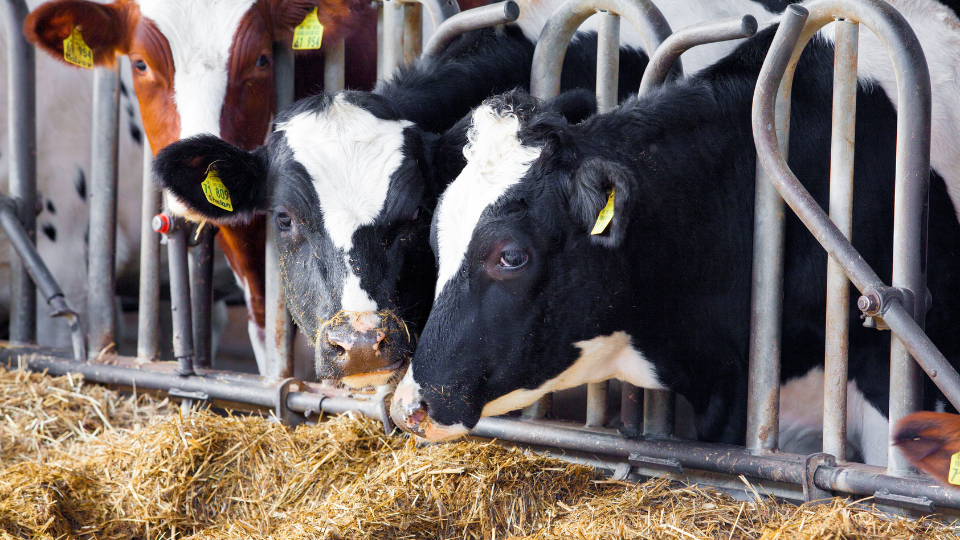Importance of a Dietary Cation-Anion Difference in Peripartum Dairy Cows

Introduction
At calving, nutrient requirements of dairy cows increase to support milk synthesis. Energy and protein requirements are increased at the initiation of lactation (Moore et al., 2000). Additionally, calcium requirements increase tremendously to meet the demands of lactation (Moore et al., 2000). Calving and subsequent milk synthesis can cause calcium concentrations in the blood to drop. When the demand for calcium exceeds the cow’s ability to mobilize calcium, hypocalcemia, or low blood calcium, occurs. Hypocalcemia in dairy cows negatively impacts production and, as such, implementing hypocalcemia prevention strategies is necessary.
Subclinical and Clinical Hypocalcemia
Normally, when low concentrations of calcium are present in the blood, parathyroid hormone is released from the parathyroid gland to increase plasma calcium (Goff et al., 2014) (see Figure 1). The secretion of parathyroid hormone results in activating mechanisms that aid in calcium homeostasis, such as calcium resorption from the bone, reabsorption of calcium from the urine, and increased production of vitamin D, which is necessary for calcium absorption (Ramberg et al., 1984). However, if sufficient concentrations of calcium, potassium, and other cations are provided in the diet throughout gestation, this causes metabolic alkalosis (elevated blood pH), which is thought to cause conformational changes in the parathyroid hormone receptor (National Research Council [NRC], 2001). These changes in the parathyroid hormone receptor prevent proper binding of parathyroid hormone to its receptor, therefore, preventing adequate calcium resorption from the bone upon the secretion of parathyroid hormone (NRC, 2001).
When mechanisms of calcium absorption from the small intestine and resorption from the bone are insufficient to meet the calcium requirements of the animal, hypocalcemia occurs. Subclinical hypocalcemia is more common than clinical hypocalcemia and occurs when blood calcium concentrations drop below 8 mg/dL, but there are no clinical signs that are displayed. Milk fever, or clinical hypocalcemia, on the other hand, is when blood calcium concentrations drop below 8 mg/dL and the cow exhibits clinical signs such as muscle tremors, lethargy, incoordination, and in extreme cases, inability to stand and loss of consciousness. To prevent hypocalcemia in dairy cows, producers can make diet modifications to prepare the cow for the onset of lactation and the high calcium demands that lactation requires.

Dietary Cation-Anion Difference Defined
Prior to calving, dairy cows should be fed a diet that results in calcium mobilization prior to calving. This diet prepares the dairy cow for the high demands of lactation and minimizes the risk of hypocalcemia. Feeding a diet that decreases the dietary cation-anion difference (DCAD) prior to calving improves calcium homeostasis (Ender et al., 1971) (see Figure 1). Cations are ions that have a positive charge, such as sodium (Na) and potassium (K), and anions are ions that are negatively charged, such as chloride (Cl) and sulfur (S). The DCAD is the difference between the cations and the anions and can be calculated in milliequivalents per 100 grams of ration dry matter using the following formula:
[(%Na+) / 0.023) + (%K+) / 0.039) – (%Cl-) / 0.0355 + (%S-2) / 0.016)]
By decreasing the dietary cations, the potential for cations to increase blood pH is limited and metabolic alkalosis, which is a contributor to milk fever, can be prevented (NRC, 2001). Instead, slight metabolic acidosis is induced, which increases the responsiveness to parathyroid hormone in the tissues (Horst et al., 1997). When tissues have increased responsiveness to parathyroid hormone, calcium resorption from the bone is also increased (Horst et al., 1997). A DCAD of -5 to -10 milliequivalents per 100 grams of dry matter has been found to be the most effective at preventing milk fever (Horst et al., 1997). To achieve a negative DCAD, producers can make a variety of modifications to the diet.
Figure 1
Preventing Milk Fever by Feeding a DCAD Diet
Negative DCAD of -5 to -10 meq/100 g
Slight metabolic acidosis induced
Tissues responsiveness to parathyroid hormone is increased
Calcium is mobilized to bloodstream
Helps prevent milk fever
Achieving a Dietary Cation-Anion Difference
In typical dairy cow rations, the combination of forages and concentrates in the diet results in a positive DCAD. To balance a diet for a negative DCAD, producers must conduct a diet analysis first to determine mineral composition. Once the mineral composition is determined, dietary modifications can be made to achieve the desired DCAD. Adding anionic salts such as magnesium sulfate, calcium chloride, or magnesium chloride to the diet can achieve a negative DCAD. However, anionic salts can be unpalatable, and feed intake will need to be monitored. To improve palatability, modern uses of anions utilize a grain coproduct with chloride. Adding anions to the diet increases the cost of the diet, but preventing milk fever may be worth the added cost. In addition to utilizing anionic salts in the diet, forages can be replaced with forages that are lower in potassium.
Lastly, dietary calcium should be increased. Urine pH can be analyzed to ensure that the DCAD is causing a slight metabolic acidosis. When blood pH drops due to a negative DCAD, urine pH will also drop. Urine pH between 6.2 and 5.5 indicates metabolic acidosis (Horst et al., 1997). Monitoring urine pH of cows in the closeup pen is necessary to check the effectiveness of feeding a negative DCAD diet and ensure that over-acidification is not occurring.
Conclusion
 Cows nearing calving and subsequent lactation onset have significantly increased calcium requirements. If calcium demands exceed the ability of the cow to mobilize calcium, hypocalcemia occurs. Hypocalcemia negatively impacts the production of dairy cows. As such, proper measures should be taken to prevent hypocalcemia. Utilization of a DCAD prevents hypocalcemia by preparing the cow for increased calcium requirements and increasing tissue responsiveness to parathyroid hormone, which subsequently increases calcium resorption from the bone. The addition of anionic salts and additional calcium to the diet can prevent incidence of hypocalcemia. Moreover, forages in the diet can be replaced for forages that are lower in potassium. Such modifications to the diet of cows nearing parturition are necessary to maintain cow health and prevent production inefficiencies caused by hypocalcemia. A DCAD diet should only be fed during the last three weeks of gestation. After calving, cows perform better on a positive DCAD diet.
Cows nearing calving and subsequent lactation onset have significantly increased calcium requirements. If calcium demands exceed the ability of the cow to mobilize calcium, hypocalcemia occurs. Hypocalcemia negatively impacts the production of dairy cows. As such, proper measures should be taken to prevent hypocalcemia. Utilization of a DCAD prevents hypocalcemia by preparing the cow for increased calcium requirements and increasing tissue responsiveness to parathyroid hormone, which subsequently increases calcium resorption from the bone. The addition of anionic salts and additional calcium to the diet can prevent incidence of hypocalcemia. Moreover, forages in the diet can be replaced for forages that are lower in potassium. Such modifications to the diet of cows nearing parturition are necessary to maintain cow health and prevent production inefficiencies caused by hypocalcemia. A DCAD diet should only be fed during the last three weeks of gestation. After calving, cows perform better on a positive DCAD diet.
References
- Ender, F., Dishington, I. W., & Helgebostad, A. (1971). Calcium balance studies in dairy cows under experimental induction and prevention of hypocalcaemic paresis puerperalis. The solution of the aetiology and the prevention of milk fever by dietary means. Zeitschrift fur Tierphysiologie, Tierernahrung und Futtermittelkunde, 28(5), 233–256. doi: 10.1111/j.1439-0396.1971.tb01573.x
- Horst, R. L., Goff, J. P., Reinhardt, T. A., & Buxton, D. R. (1997). Strategies for preventing milk fever in dairy cattle. Journal of Dairy Science, 80(7), 1269–80. doi: 10.3168/jds.S0022-0302(97)76056-9
- Goff, J. P., Liesegang, A., & Horst, R. L. (2014). Diet-induced pseudohypoparathyroidism: A hypocalcemia and milk fever risk factor. Journal of Dairy Science, 97(3), 1520–28. doi: 10.3168/jds.2013-7467
- Moore, S. J., VandeHaar, M. J., Sharma, B. K., Pilbeam, T. E., Beede, D. K., Bucholtz, H. F., Liesman, J. S., Horst, R. L., & Goff, J. P. (2000). Effects of altering dietary cation-anion difference on calcium and energy metabolism in peripartum cows. Journal of Dairy Science, 83(9), 2095–104. doi: 10.3168/jds.S0022-0302(00)75091-0
- National Research Council (NRC). (2001). Nutrient requirements of dairy cattle (7th revised ed.). The National Academic Press.
- Ramberg Jr., C. F., Johnson, E. K., Fargo, R. D., & Kronfeld, D. S. (1984). Calcium homeostasis in cows, with special reference to parturient hypocalcemia. American Journal of Physiology, 246, R698–R704. doi:10.1152/ajpregu.1984.246.5.R698
March 2022
Utah State University Extension
Peer-reviewed fact sheet
Authors
Laura A. Motsinger, Ph.D., and Jake A. Hadfield, M.S.


 Utah 4-H & Youth
Utah 4-H & Youth